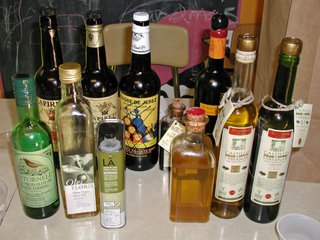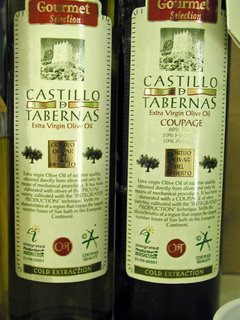Spanish Olive Oil and Vinegar Tasting
 It's Spain month at Zingerman's, and last night I attended a tasting of Spanish olive oils and vinegars. Unlike most of their tastings, this one was pretty lightly attended - just 7 of us plus Gauri, our friendly and helpful guide for a tour through Spain.
It's Spain month at Zingerman's, and last night I attended a tasting of Spanish olive oils and vinegars. Unlike most of their tastings, this one was pretty lightly attended - just 7 of us plus Gauri, our friendly and helpful guide for a tour through Spain.
We started off by tasting 6 olive oils, alone and with bread. As with wine tasting, we started off by looking at the oil, then smelling it, and - finally - slurping it loudly to taste it. The flavor of the oil changes depending where on your tongue it's landing, so it's interesting to note how it evolves on its way down your palate. And you must watch out for the hit of pepper that can grab your throat on the way down. (In Italy, Gauri told us, they judge oils based on whether they are a "one-cough" or "two-cough" oil.)
The first two we tasted were both from near Barcelona, and both made exclusively from Arbequina olives. They were both a bright sunny yellow, with only a hint of green. The first, L'estornell, was a very light oil, with a fruity, grassy nose. It was the mildest of the oils we tasted, inspiring words like "silky, smooth, and delicate." It had just the slightest hint of pepper. The second, Olei Floris, had a very different nose with very strong aromas of tropical fruits and flowers. While the nose was interesting, the taste seemed really off to me - almost as if it was on the edge of rancidity. I raised it to Gauri's attention, and sure enough, a fresh bottle showed none of the characteristic I'd found objectionable. Whereas the L'estornell was very light, this oil was very viscous and thick, and the flavor was correspondingly round and full. Next, we moved South in Spain, to the Tabernas dessert. Where the oils of the North are mostly made from Arbequina olives, those from the south rely exclusively or in part on the Picual olive. The flavor from the Picual is much more assertive, and apparently Southerners refer to the oils of the north as "cat piss."
Next, we moved South in Spain, to the Tabernas dessert. Where the oils of the North are mostly made from Arbequina olives, those from the south rely exclusively or in part on the Picual olive. The flavor from the Picual is much more assertive, and apparently Southerners refer to the oils of the north as "cat piss."
Well, we all said upon sampling this next oil, we'd be thrilled if our cats pissed this! The Castillo de Tabernas 100% Picual oil was light green, with moderate viscosity. It was green on the nose too, with lots of different herbal aromas and a hint of mint. The flavor is green and quite assertive, with lots of pepper in the throat. Very different from the preceding Arbequina based oils - rustic rather than refined.
And very different from the next oil, a blend from the very same producer. The Castillo de Tabernas - Coupage is a blend of 60% picual, 20% arbequina, and 20% hoji blanca. A bright yellow-green oil, both the color and viscosity were lighter than the preceding oil. The nose was very floral. In taste, this was a very fresh and smooth tasting oil, with a hint of lemon or other citrus, and a lot of complexity. Tasting these two side by side illustrated the power of the blend - the 100% Picual oil was noticeably less complex, with a lot of up front flavor and a lot of pepper on the finish, but nothing in the middle.
Next up was La Amarilla de Ronda. (You can see its stylish "LA" can next to the L'estornell and Olei Floris above.) Another blend of Arbequina, Picual and Hoji Blanca, this oil is made by a producer who is best known for making wine. He's taken a very winemaker-ish approach to olive oil, and purchases oil from two different villages, carefully blending them in an attempt to reflect the flavor of the region. (Gauri said that this all felt really pretentious to her, so she really wanted to dislike this oil. But then she tasted it.) Another yellow-green oil, with a nose of flower and fruit, it had quite the interesting evolution in my mouth. It opens very mild, then has a hint of fruity sweetness, before a really assertive peppery bite on the finish. Having taken a perhaps too-large slurp, I rated this one a three-cough! Very interesting.
The sixth and final oil was quite different from all the rest. Mariano's oil is from a town very close to the border of Portugal, at about the midway point north to south. It's made of 100% Manzanilla olives (not the kind usually marketed under that name, but a cousin). It was quite a pale yellow, with a very flowery and sweet nose. The nose was completely deceiving, however, as the flavor was extremely different from what the nose implied! It was very herbal and reminded me distinctly of oregano. It was quite complex and interesting, with a bitter finish that made it distinct from all of the other oils we tasted. It was also the oil that tasted most different with bread than on it's own, once again tricking your expectations. (In the topmost picture of this post, the Mariano's is the short square bottle in the front middle.)
And that was our pass through the olive oils. Next up: five very different Sherry vinegars.
1 comment:
Very nice collection of spanish olive oils here! Thanks for the great information.
Post a Comment